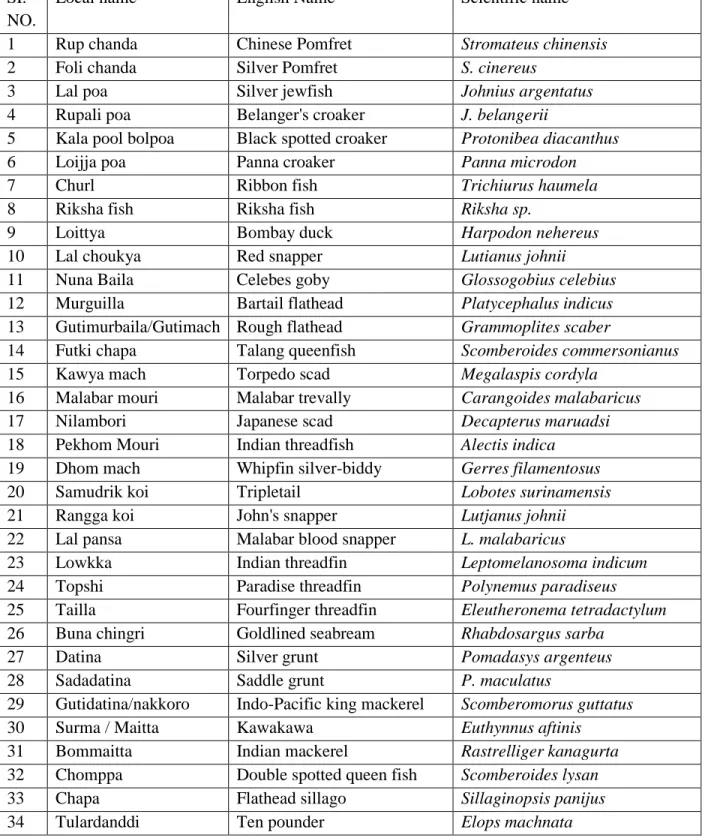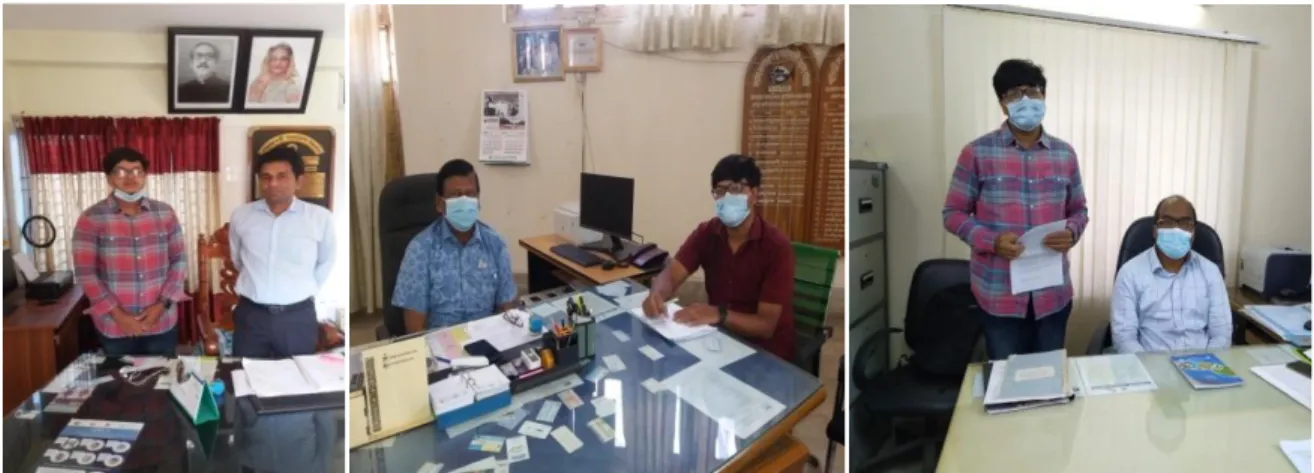STUDIES ON THE SOCIO-ECONOMIC STATUS OF THE DIFFERENT STAKEHOLDERS INVOLVED IN THE SEA FISH MARKETING CHANNEL. 21 Flowchart sales channel pomfret fish 52 22 Flowchart sales channel hilsha fish 52 23 Flowchart sales channel loytia fish 53 24 Flowchart sales channel ribbonfish 53.
ABSTRACT
Diversity of Fishing Gears, Craft and Catch Composition
According to their research, despite being a legally prohibited fishing technique, the estuarine bag net (ESBN) recorded the highest catch per unit effort (CPUE) (110 kg/gear/day) in July, followed by the marine bag net (MSBN). (105 kg/gear/day) in Cox's Bazar, and the highest CPUE was recorded in June by ESBN at 100 kg/gear/day, followed by MSBN (90 kg/gear/day) in 52 fish species. Compared to the other two gears, fishing with fixed nets proved to be more profitable.
Marketing Channel Analysis
The majority of the explanatory factors included in the model were statistically significant and had a favorable impact on improving fishing income according to Cobb Douglas production function analysis. The aim was to maximize opportunities to understand the different attitudes and viewpoints held by the members of the communities (Gaskell 2000).
Methods for data collections for livelihood analysis
- Preliminary survey
- Participant and direct observations
- Interviews
- Secondary documents analysis
- Sampling and representativeness
Although priority was given to interviews at the workplace or in living quarters, we adapted the time and place of the interview to the physical and psychological condition of the fishermen and their availability, thus avoiding busy working hours. The size of the interview sample was determined based on information requirements and the principle of data saturation (Polit & Hungler 1999; Glaser & Strauss 1967).
Data Collection for Catch Assessment
- Collection of Data
- Estimation of monthly total catches
The Cox's Bazar, Ukhiya and Teknaf Upazila are in the south-eastern part of Bangladesh. Within each community, sampling was mainly carried out in the places where the fishermen gather.
Method of data analysis of Socio-Economic Analysis
Study area
Location of the study area
Sampling Unit
Study period
Ensuring good scientific practices .1 Validity and reliability
Being dissatisfied with the activities of various NGOs (which usually visit local communities and do various surveys), many people on the coast are not interested in qualitative interviews, as we experienced. On the one hand, some fishermen exaggerated their living restrictions in the hope that we would offer help.
Ethical considerations
- Age structure
- Religion Status
- Educational qualification
- Economic Condition
- Commonly Used Fishing Nets
They occupied 13% in Teknaf Upazila and 4% and 1% in Cox's Bazar and Ukhiya Upazila respectively (Figure 3). They had 3% of the population in Ukhiya Upazila and consequently 2% and 1% in Cox's Bazar and Teknaf Upazila (Figure 4). In terms of educational facilities, they showed about 44%, 31% and 25% of lack of educational facilities in Ukhiya, Cox's Bazar and Teknaf Upazila.
In terms of scarcity of food, Ukhiya also showed the highest number of shortage of food around 43%, where Cox's Bazar and Teknaf showed around 22 and 35% respectively. The highest number of social conflicts was shown in Ukhiya Upazila around 51% while Cox's Bazar and Teknaf showed 19% and 30%.
Maitta Jal
Depending on the species of fish, their composition and their modes of operation, there were basically three types of nets found to operate out of Cox's Bazar. On the basis of nets, there are variations in species composition, mesh size, depth, length and catch width. The range of nets come in a variety of styles, each with a distinct mesh size, depth, length and composition of species.
Tong Jal
Illish Jal
Vasha Jal
Ton Jal
Moda Jal
Marine Set Bag Nets (MSBNs)
Lakkha Jal
Lal Jal
Char Shuta Jal
Behundi jal (Set bag net)
Kukkuru jal (Drag net)
Tana Ber jal (Shore Seine net)
Floats and sinkers are attached using plastic rope, which is also used as a main rope and weight. Illish Jal Lal Jal Lakkha Jal Char Shuta Jal Behundi Jal Hangor Jal Moda Jal Ton Jal Vasha Jal Current Jal. Current Jal: This kind of nylon yarn usually measures 25 meters in length and 5 meters in width.
Current Jal: This kind of nylon twine net normally measures 25 meters in length and 5 meters in breadth. The mesh size is relatively modest to accommodate fish of various sizes
- List of Shrimp (Table 5) SI
Fish is generally harvested in Bangladesh using different types of fishing vessels from the coastal and offshore areas. Smaller boats are used in coastal rivers, canals and estuaries (such as the Kosha and Dingi frames. Smaller boats are used in coastal rivers, canals and estuaries (such as the Kosha and Dingi nauka).
Motorized Dinghies both in construction and design are similar to non-mechanized Dinghies, are larger in size and powered by marine engines. Fishermen in Cox's Bazar, Ukhiya and Teknaf used a range of fishing gear to collect data on the seasonal shift in species abundance.
Depth of Operation
Marketing System of Marine Fish
More than 95% of the fish produced in the country is handled by the private sector in this network of business linkages that connect fish farmers with fish consumers. To identify the marketing channels used in marine fish trade, the main species (Table 1) that account for more than 80% of traded marine fish were selected for the present study. In addition to producers, it is shown that sellers of various categories engage in marine fish marketing channels in the research regions in frozen and dried fish distribution channels (Figs. 2 and 3).
There are a select few producers who can transport their fish to wholesale markets (arat) in the city or district markets because they have more boats and a large amount of catch. They often buy fish from the farmers at landing sites and transport their goods to various arats centers for sale.
Marketing Channel of the Most Available Marine Fishes
As part of marketing chain III, dried Bombay duck from the drying yard was distributed and sold locally through a distributor and store. Hilsha fish was sent by fishermen to the processing plant, warehouse, and export market as part of marketing chain I. Aratdars, or middlemen, assisted fishermen in moving their fish by tape to the drying yard in marketing chain I.
As part of market chain II, we distributed dried fish from the dryer to a distant customer via a wholesaler and a far wholesaler. The dried fish were sent directly from the dryer to the export market in the market chain III.
Marketing Channel of Frozen Marine Fish
Through a distant distributor and trader, dried Bombay duck was sent from the drying depot to customers who lived far away. Hilsha fish was transported through landing centers, distant paikers, distant wholesalers and distant retailers in marketing chain II from fishermen to distant customers. Through marketing chain III, Hilsha fish was distributed from fishermen to local wholesalers and retailers and then sold to local customers (Figure 46).
As part of the marketing chain IV, the striped fish from the fishermen were distributed to the distant customers through landing centres, paiker/aratdar, far market wholesalers and far market retailers. Banded fish from local fishermen were sold to local customers in the V marketing chain through middlemen, local markets, wholesalers and local retailers (Figure 48).
Marketing Channel of Dried Marine Fish
Few species from this great abundance of fish are in high demand in the dried fish market because of their taste and accessibility. The aim of this study was to illustrate the socio-economic status of artisanal fishers in Cox's Bazar, Teknaf and Ukhiya areas and to identify the features of small-scale fisheries in the area along with the marine fish marketing channel.

Fishing crafts and gears
Chandi Nauka were discovered in Teknaf, but they were not used for fishing, but were used to carry bamboo baskets filled with fish during low tide when the water level was so low that fishing boats could not reach the landing site. . 2016) found four different types of fishing gear including Chor jal (fenced net), fine gillnets, beach seines and estuarine nets (ESBN) used for fishing in the Naaf River. According to Sarowar et al. 2009), cast net fishing is the method used by most fishermen in the Khulna region, followed by seine nets, trawl nets, drift nets and push nets. Differences in the tools used may be due to geographic preferences and livelihoods.
The current research discovered the combination of inboard motors and wooden Chandi and Balam boats in small-scale fisheries. The findings of the present study are consistent with those of FAO (1985), which identified the Dinghi, Chandi and Balam as the three main types of traditional boats used in artisanal coastal fishing.
Socio economic characters
According to Momotaz's (2009) research on the socio-economic status of the beneficiaries of small indigenous species in three countries, 53 (84%) of the fishermen were married, while the remaining 16% were single. The result is comparable to the result of Shamima (2000) who conducted a study in Gallamary fishing village found that most of the floor materials of the fishermen 94% were Katcha. The result differs from that of Shamima (2000) who found that 20% of fishermen in Gallamary fishing village of Khulna used electricity.
According to the current survey, all fishermen in Cox's Bazar region are illiterate. As the outcome of the current study is comparable to that of Ahamed (1999) in the estuary regions 10 with literacy rates of 25% and 23% respectively, the difference may be due to the availability of amenities in the study area.
Marketing channel analysis
Akhtar, A, Bhuiyan, MA, Mia, MM., Islam, MS & Bhuyan, MS 2017 'Livelihood Assessment of Artisanal Fishermen in and Around the Chattogram Coastal Area of Bangladesh', Social Change, vol. Islam MR (ed) (2004) Where land meets sea: a profile of the coastal zone of Bangladesh. Arthur Rahman AFM, Anisunaman M (2012) Livelihood status of fisherman of Kirtonkhola river near Barisal town.
Report of the Stock Assessment Consultation for Small Scale Inshore Fisheries in the Bay of Bengal, Chittagong, Bangladesh, June. Mridula Rani Das, Sunuram Ray, Uttam Kumar, Salma Begum and Satya Ranjan Tarafdar Livelihood Assessment of a Fishing Community in the Southwest Region of Bangladesh. A case study of gear and vessels used for artisanal fishing in Chattogram Patharghata Fishery Ghat, Bangladesh and socio-economic status of fishermen.
Rahman, SM 2017 'Marketing challenges faced by poor fishing communities of rural Bangladesh', Society & Change, pp.7-18.

